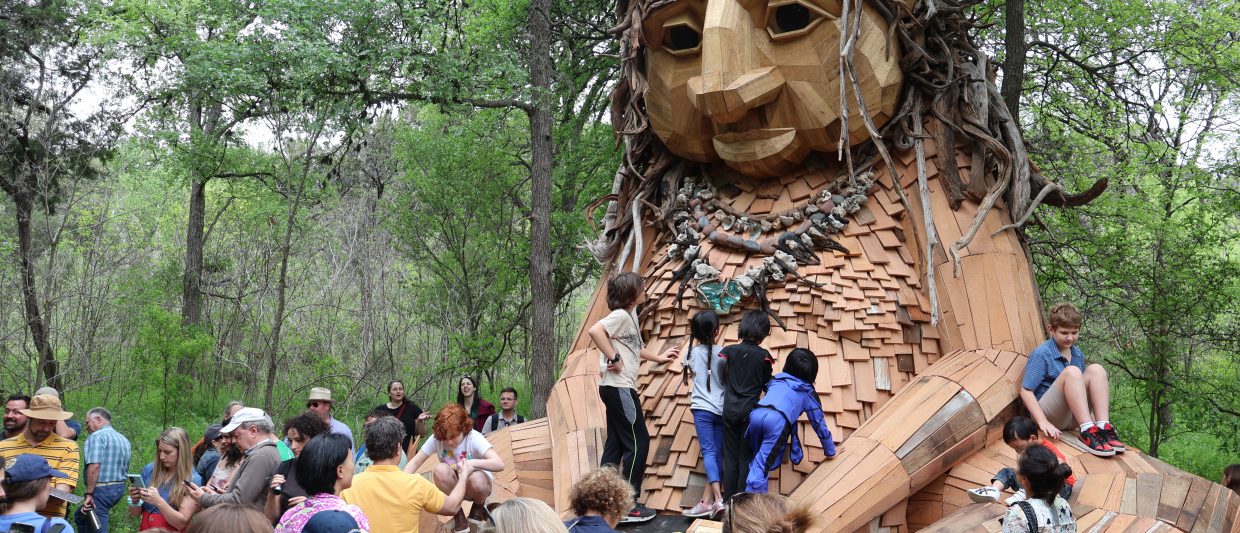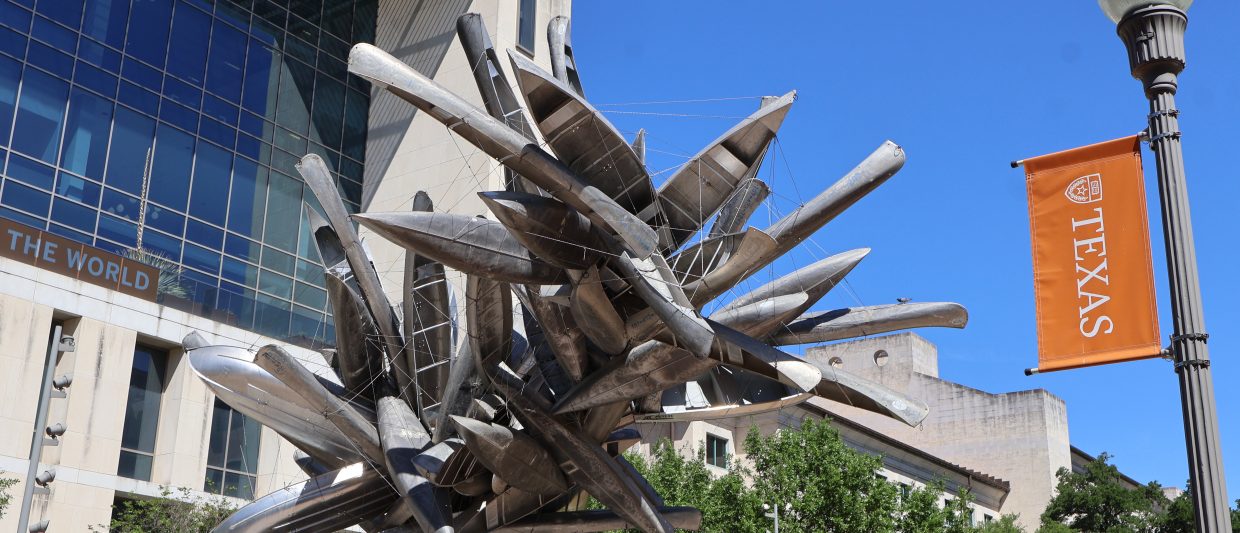Giant Troll Highlights Recycled Art in Austin
By Isabella McGovern
Reporting Texas

People gather to take photos of Malin’s Fountain at its unveiling at Pease Park Conservancy in Austin, Texas, on March 15, 2024. Children are able to climb on the recycled material sculpture. Isabella McGovern/Reporting Texas
The piles of Douglas Fir and cedar sat in Pease Park, waiting to be repurposed into Austin’s newest public artwork. The Douglas Fir had once been a research test tank at the J.J. Pickle Research Campus of the University of Texas. Now it was destined to be an 18-foot troll — and a testament to recycling.
“My art is not about trolls; it’s about trash,” said Thomas Dambo, the Danish sculptor brought to Austin to create “Malin’s Fountain,” his 129th troll around the world.
While the trend of making art from recycled materials is not new, Dambo’s troll artwork proved to be a good match for environmentally conscious Austin benefactors.
“The message that you gave of making trash into treasure and really learning from our art about how we need to be in the world is one that really resonates here in Austin,” Austin City Council Member Alison Alter said during the Pease Park Conservancy’s welcoming of Dambo on March 1 as he began his work. “This is a city park, and we are really fortunate to have an internationally renowned artist citing this piece here.”
Lynne Dobson and Greg Wooldridge, whose philanthropic giving has been focused on educational and environmental causes, spearheaded the drive to bring Dambo to Austin after seeing one his trolls in Maine. They worked with the Pease Park Conservancy and other groups to enlist Dambo to create Malin’s Fountain at a cost of $350,000. It will watch over Pease Park for the next 15 years.
“Like he says, trash into treasure but with the whimsy and the delight that the trolls bring we need that in our world,” Dobson said.
From hair made of cedar roots to a necklace made from donated pieces of stone, glass and shells, “Malin’s Fountain” is entirely made of local recycled materials collected or donated by the community of Austin.
Dambo says the purpose of his art is to show that with our hands and the help of our community, we can make big things — in this case, giant sculptures — out of materials we throw away. To Dambo, trash is a resource. It equals wealth, money and opportunity.
“Instead of drowning in our own trash, we can build beautiful things and a good future out of our trash,” Dambo said. “Trash made me who I am.”
Nearby at the University of Texas, one of the prominent works in the university’s Landmarks public art program also features recycled materials — 70 small boats and canoes suspended above the corner of Speedway and 24th Street.

“Monochrome for Austin,” an art installation of aluminum canoes, stands on the corner of Speedway and 24th street at the University of Texas at Austin, Texas, on April 5, 2024. Artist Nancy Rubin reused old aluminum boats to create the sculpture. Isabella McGovern/Reporting Texas
Artist Nancy Rubin used aluminum boats because it is a material that is more efficient to recycle than it is to extract more material from the Earth, said Landrmarks digital content coordinator Logan Larsen.
“She likes to see these boats as having past lives of material, so they could have been airplanes or other large aluminum structures,” Larsen said. “Her work is so much about these materials that are recyclable and that have been discarded and that have a second life as an art project.”
Rubin’s “Monochrome for Austin” was completed in 2015 and remains one of the most prominent outdoor artworks on campus and continues to inspire conversation.
“Public art projects that think about sustainability and think about the role that materials play is really exciting,” Larsen said, “and I’m always happy to stumble across something that has a material shift that uses the material that I wouldn’t have expected it to be.”
Dambo, whose studio is in the outskirts of Copenhagen, said there is still a lot of wood left in the world that can be recycled rather than thrown in a landfill or burned. Dambo believes people should put trash as a priority for change.
“A lot of it just gets driven to the landfill because we haven’t educated our world what actually happens when we throw stuff out,” Dambo said. “We build new houses on top of our old landfills. That’s what we have to change; that’s my mission as an artist.”
Education will be part of Malin’s mission. Dambo’s troll will be a part of Pease Park Conservancy’s Peasecology School Field Trip program where schools can come for an ecology tour and learn about plants, animals and the environment. The staff of Pease Park conducts this outdoor learning experience through a curriculum designed by the Conservancy and inspired by Families In Nature’s Ecologist Guidebook.
“We’ll incorporate (Thomas Dambo’s troll) as sort of a stop for the kids to get to see it as a part of their day while they’re here,” said Allison Johnson, the conservancy’s director of community engagement.
Malin’s Fountain features a poem that is about sharing water with animals.
“I thought that it would be cool to make a sculpture that kind of reminded us that we have to remember to share the world with the other species like share our water with them so we don’t hog all the water and then there’s nothing left for the animals,” Dambo said. “It’s our responsibility to remember to share resources on the land with the animals otherwise they won’t be here.”
The fountain is a disc, carved with troll symbols, that is held in the hands of the troll. The bowl will be able to collect rainwater and water from parkgoers who want to share from their bottles. It is crafted from bronze and was shipped to Austin from Mexico.
“I think it’s really cool to have something like this made in a park for the community,” said UT student Christina Lopez. “I think we need to do more with recycled art because we just keep making new stuff and there’s other things that we can utilize to make interactive art.”